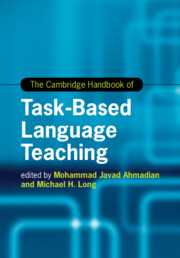Book contents
- The Cambridge Handbook of Task-Based Language Teaching
- Cambridge Handbooks In Language And Linguistics
- The Cambridge Handbook of Task-Based Language Teaching
- Copyright page
- Dedication
- Contents
- Figures
- Tables
- Contributors
- Preface The Origins and Growth of Task-Based Language Teaching
- Part I The Rationale for Task-Based Language Teaching
- Part II Tasks and Needs Analysis
- Part III The Task Syllabus and Materials
- Part IV Methodology and Pedagogy
- Part V Task-Based Language Teaching with School-Age Children
- 11 Child Interaction in Task-Supported EFL/CLIL Contexts
- 11A Tasks for Children
- 11B A Case Study of a Task-Based Approach for School-Age Learners in China
- Part VI The Teacher in Task-Based Language Teaching
- Part VII Task-Based Assessment and Program Evaluation
- Part VIII Research Needs and Future Prospects
- Index
- References
11 - Child Interaction in Task-Supported EFL/CLIL Contexts
from Part V - Task-Based Language Teaching with School-Age Children
Published online by Cambridge University Press: 19 November 2021
- The Cambridge Handbook of Task-Based Language Teaching
- Cambridge Handbooks In Language And Linguistics
- The Cambridge Handbook of Task-Based Language Teaching
- Copyright page
- Dedication
- Contents
- Figures
- Tables
- Contributors
- Preface The Origins and Growth of Task-Based Language Teaching
- Part I The Rationale for Task-Based Language Teaching
- Part II Tasks and Needs Analysis
- Part III The Task Syllabus and Materials
- Part IV Methodology and Pedagogy
- Part V Task-Based Language Teaching with School-Age Children
- 11 Child Interaction in Task-Supported EFL/CLIL Contexts
- 11A Tasks for Children
- 11B A Case Study of a Task-Based Approach for School-Age Learners in China
- Part VI The Teacher in Task-Based Language Teaching
- Part VII Task-Based Assessment and Program Evaluation
- Part VIII Research Needs and Future Prospects
- Index
- References
Summary
The present chapter focuses on the benefits of task-supported interaction among child foreign language learners. It reviews research carried out in English as a foreign language (EFL) and content and language integrated learning (CLIL) contexts, and highlights the affordances of child–child interaction in settings where access to input is restricted. The chapter provides a rationale for the increasing interest in research with the underexplored population of young learners in foreign language contexts. It also features a summary of the main findings from research carried out to date within two frameworks, namely, interactionist (Long, 1996) and sociocultural (Vygotsky, 1978). The children in the studies are in the so-called middle childhood stage, a developmental stage characterized by their becoming more logical in their thinking. The studies chosen for this chapter have considered the importance of negotiation of meaning and the impact of repeating a task on interactional patterns, attention to language form, complexity, accuracy and fluency of production and the use of the first language. The contribution ends with several suggestions for further research with young learners.
Information
- Type
- Chapter
- Information
- The Cambridge Handbook of Task-Based Language Teaching , pp. 397 - 415Publisher: Cambridge University PressPrint publication year: 2021
